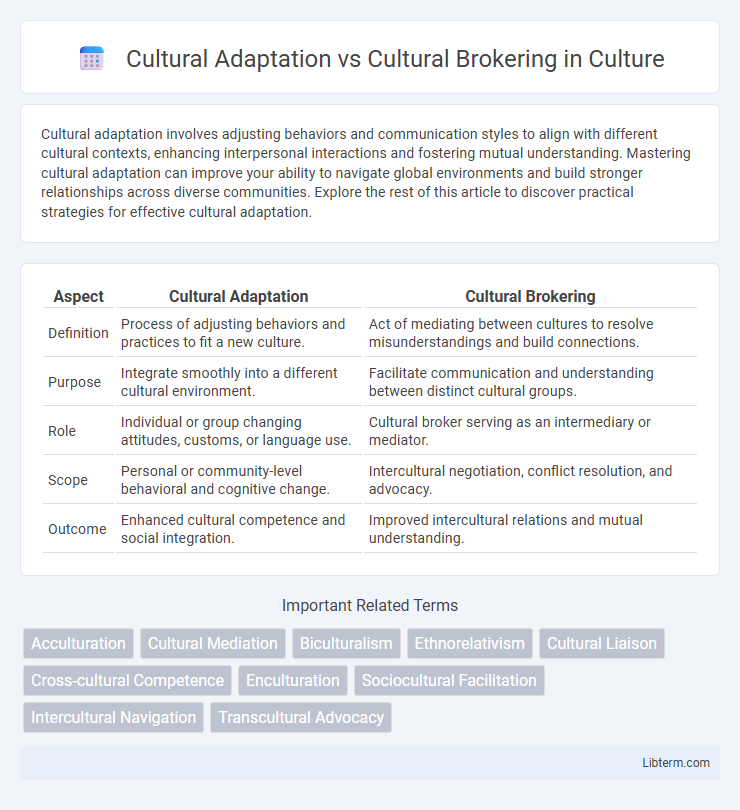Cultural adaptation involves adjusting behaviors and communication styles to align with different cultural contexts, enhancing interpersonal interactions and fostering mutual understanding. Mastering cultural adaptation can improve your ability to navigate global environments and build stronger relationships across diverse communities. Explore the rest of this article to discover practical strategies for effective cultural adaptation.
Table of Comparison
| Aspect | Cultural Adaptation | Cultural Brokering |
|---|---|---|
| Definition | Process of adjusting behaviors and practices to fit a new culture. | Act of mediating between cultures to resolve misunderstandings and build connections. |
| Purpose | Integrate smoothly into a different cultural environment. | Facilitate communication and understanding between distinct cultural groups. |
| Role | Individual or group changing attitudes, customs, or language use. | Cultural broker serving as an intermediary or mediator. |
| Scope | Personal or community-level behavioral and cognitive change. | Intercultural negotiation, conflict resolution, and advocacy. |
| Outcome | Enhanced cultural competence and social integration. | Improved intercultural relations and mutual understanding. |
Understanding Cultural Adaptation
Cultural adaptation involves the process through which individuals adjust their behaviors, values, and communication styles to align with a new cultural environment, enhancing social integration and reducing cultural conflicts. This dynamic adjustment promotes better interpersonal relationships and effective participation in diverse societies by bridging cultural gaps. Understanding cultural adaptation requires recognizing the psychological and social challenges encountered during acculturation and the strategies employed to achieve cultural competence.
Defining Cultural Brokering
Cultural brokering involves mediating and facilitating communication between individuals or groups from different cultural backgrounds to promote understanding and reduce conflicts. Unlike cultural adaptation, which emphasizes personal adjustment to a new culture, cultural brokering actively bridges cultural gaps by interpreting values, norms, and behaviors. This role is critical in healthcare, education, and social services to ensure culturally appropriate and effective interventions.
Key Differences Between Adaptation and Brokering
Cultural adaptation involves individuals adjusting their behaviors and communication styles to align with a new cultural environment, emphasizing personal change and integration. Cultural brokering, in contrast, entails mediating and facilitating understanding between two or more cultural groups by translating norms, values, and expectations. Key differences include adaptation focusing on self-transformation within a culture and brokering emphasizing active mediation roles to bridge cultural gaps.
The Role of Context in Cultural Navigation
Cultural adaptation involves individuals adjusting their behavior and communication styles to align with a new cultural environment, emphasizing immersion and personal transformation. Cultural brokering, on the other hand, requires mediating and facilitating understanding between different cultural groups, often leveraging knowledge of both contexts to bridge gaps. The role of context is crucial in cultural navigation, as successful adaptation or brokering depends on recognizing specific cultural norms, social cues, and environmental factors influencing interactions.
Challenges in Cultural Adaptation
Cultural adaptation presents challenges such as overcoming language barriers, navigating differing social norms, and managing identity conflicts that arise from integration into a new culture. Individuals often face psychological stress and a sense of alienation while adjusting to unfamiliar customs and values. These obstacles can impede effective communication and social inclusion without targeted support and intercultural competence development.
Skills Required for Effective Cultural Brokering
Effective cultural brokering requires advanced cross-cultural communication skills, including fluency in multiple languages and deep cultural knowledge to accurately mediate between diverse groups. Strong interpersonal skills, such as empathy, active listening, and conflict resolution, are essential to build trust and facilitate mutual understanding. Cultural brokers also need adaptability and critical thinking abilities to navigate complex cultural dynamics and bridge gaps between conflicting values or practices.
Impact on Communication and Relationship Building
Cultural adaptation enhances communication by enabling individuals to modify their behaviors and language to align with different cultural norms, fostering deeper mutual understanding and trust. Cultural brokering actively mediates between distinct cultural groups, bridging gaps through translation, negotiation, and conflict resolution to facilitate effective interactions. Both processes significantly improve relationship building by reducing misunderstandings and promoting cooperation across diverse cultural contexts.
Case Studies: Adaptation vs. Brokering Scenarios
Case studies reveal that cultural adaptation involves individuals modifying their behaviors to align with the host culture, enhancing interpersonal integration but risking loss of original cultural identity. In contrast, cultural brokering entails mediators facilitating communication and understanding between distinct cultural groups, effectively bridging cultural gaps without requiring complete assimilation. Scenarios in healthcare and education demonstrate brokering's critical role in resolving cross-cultural misunderstandings, while adaptation is often seen in immigrants striving to function within new societal norms.
Enhancing Cross-Cultural Competence
Cultural adaptation involves learning and adjusting behaviors to align with a new cultural environment, enhancing cross-cultural competence by developing empathy and communication skills. Cultural brokering serves as a bridge between different cultural groups, facilitating understanding and reducing conflicts through mediation and advocacy. Both processes are essential for effective intercultural interactions, promoting inclusivity and mutual respect in diverse settings.
Strategies for Success in Multicultural Environments
Cultural adaptation involves adjusting behaviors and attitudes to align with a new cultural environment, utilizing strategies like active listening, empathy, and open-mindedness to bridge cultural gaps. Cultural brokering, by contrast, acts as an intermediary role to facilitate communication and understanding between different cultural groups, employing negotiation skills, cultural knowledge, and conflict resolution techniques. Success in multicultural environments depends on combining both approaches--developing cultural competence through adaptation and leveraging brokering strategies to mitigate misunderstandings and foster collaboration.
Cultural Adaptation Infographic

 libterm.com
libterm.com